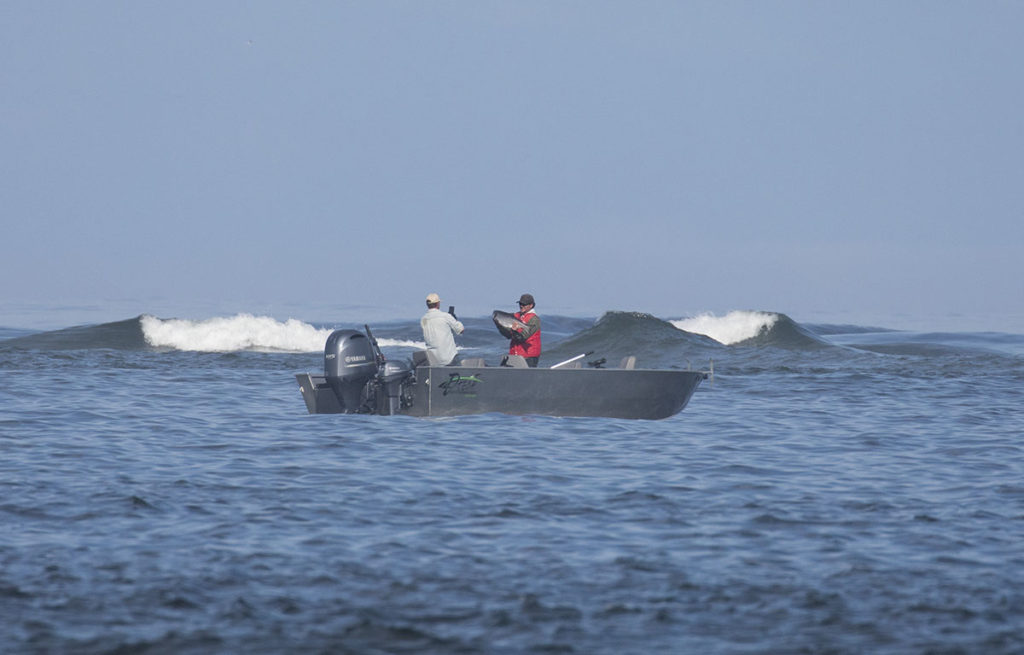
By QUINTON SMITH/YachatsNews.com
The recreational season for fall Chinook on the central Oregon coast opens Saturday, but fishermen should not expect to see much improvement in catches over the past few years from the Siletz River south to the Siuslaw.
A dramatic cutback of catch limits for wild fall Chinook that started in 2019 will continue this fall. And, for the Yachats and Siuslaw rivers, it gets even more restrictive.
“We’re still in the trough (of low Chinook returns),” said John Spangler, the Oregon Fish and Wildlife Department biologist for the mid-Oregon coast. “But the forecast is a little better, so we may be coming out of it.”
It all has to do with ocean conditions conducive to providing lots of forage for Chinook salmon, which spend 1-5 years at sea. Conditions seem to be slowly improving, Spangler said, but they were poor 2-3 years ago when most of this fall’s returning salmon migrated out from coastal rivers.

While no one is exactly sure what that means until this fall’s salmon show up, Spangler expects it will generally result in fewer and smaller than average fish.
“We’ve had these downturns before,” he said. “If the ocean becomes nice and productive then we recover pretty quickly.”
But no one is sure when – or if – that might be.
Spangler said last year there was a plume of warm ocean water that stretched from Oregon to the Gulf of Alaska that affected salmon survival and growth.
But so far this summer, he said, there’s been “really cold” ocean surface temperatures in the upper 40s stretching 4-5 miles off the Oregon coast. That’s 10 degrees below normal “and really good for fish,” Spangler said.
Nearly all the fall Chinook returning to the central Oregon coast are “wild” fish, meaning they are not raised in state or federal hatcheries and have much lower limits on the number that can be caught. The only fall Chinook hatchery program on the central coast is in the Salmon River north of Lincoln City. People can catch up to 20 hatchery salmon and steelhead a year.
Last year ODFW instituted a 5-fish season bag limit for wild fall Chinook on major streams from the Siletz River in the north to the Siuslaw in the south. Before last year bag limits for wild fall Chinook were two fish per day and 20 for the season.
The last time the state restricted fall Chinook catches to that degree was in 2008-09.
But on the Yachats River, where Chinook fishing at the mouth ranges from about 100 to 275 landings a year, the season limit last year was two fish. That has been reduced even farther this year to just one fall Chinook.
“That’s as close to a closure as you are going to get,” Spangler said.
Chinook fishing is closed in Tenmile and Big creeks south of Yachats.
Returns to the Siuslaw River at Florence and the Coquille River at North Bend have been “particularly low” ODFW said in a June news release, and therefore bag limits on those rivers have been reduced to one wild fish in the Siuslaw system and a complete closure in the Coquille basin.
Spangler said fishermen sometimes link ocean fishing for Chinook with how runs will be in coastal streams. But the Chinook runs are different, he said. Chinook being caught now in the ocean are headed north to the Columbia River or south to the Klamath and Sacramento rivers. Chinook headed up coastal rivers originate in water off Alaska and Canada.
Again this year, the keeping of any mid-coast wild coho salmon, which is listed as threatened under the federal Endangered Species Act, is prohibited.
There are no large coho hatchery programs on the central coast, Spangler said. Fishermen will occasionally catch some adipose-clipped coho – they are legal to keep – but they are strays heading to north coast rivers straying into local rivers chasing bait.

Here is a stream-by-stream breakdown of bag limits Aug. 1 through Dec. 31:
- Alsea River, including Drift Creek: No more than one adult wild Chinook salmon per day and five for the period. Five jack salmon per day.
- Siletz River, Siletz Bay, Drift and Schooner creeks: No more than one adult wild Chinook salmon per day and five for the period. Five jack salmon per day.
- Yaquina River including Big Elk Creek: No more than one adult wild Chinook salmon per day and five for the period. Five jack salmon per day.
- Yachats River: No more than one adult, wild Chinook salmon for the period. Five jack salmon per day.
- Siuslaw River, including the North Fork Siuslaw: No more than one adult, wild Chinook salmon for the period. Five jack salmon per day.
- Coquille River basin: Closed.



